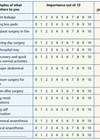OAB Answers is a patient decision aid co-authored by several European urologists and gynaecologists, and two patient advocates, to help patients understand and manage their overactive bladder (OAB).
It is a 36-page document split into several clear sections, aiming to educate patients about their condition and outline the three main treatment options beyond lifestyle and medical management. Support for this document included sponsorship from Medtronic who helped to isolate suitable steering-group personnel but were not involved in the committee workshops.
Historically, clinician-led decision making has been an acceptable way of treating patients with a urological condition in which more than one management option exists. The clinician’s role in modern day practice has evolved, meaning that we are able to present unbiased information to patients regarding their choices, to allow them to settle on an option that suits them best. This can be challenging in a time-limited consultation, combined with the increasing numbers of patients requiring help in an ageing population.
Patient decision aids (PDAs) help patients to make informed choices after considering the risks, benefits and personal impact of any given treatment. They also encourage a dialogue between the patient and their healthcare professionals, empowering them to ask questions and lead the decision-making process. Of course, it must be acknowledged that not all patients appreciate shared decision making, and some may prefer to trust their healthcare professional to make the right decision for them. This PDA recognises this, and after explaining the benefits of the shared decision-making approach it validates individuals’ rights to allow clinicians to lead decision making if preferred.
The first section of this PDA sets the scene for the overactive bladder, explaining the function of a normal bladder and tests which may be required to reach a diagnosis. It mentions the fact that there may be underlying medical conditions which cause the symptoms but reassures the reader that it is a very common condition for which multiple treatment options exist. It stresses an important point that patients who do not get on well with one treatment may respond well to an alternative. It encourages patients to persevere, not to be embarrassed by their symptoms, and to advocate for themselves. By educating patients using this tool it empowers them to do just this. We know that there is a high ‘drop out’ rate for treatment of OAB, and so stressing this point throughout the document is valuable. The emphasis on psychological and emotional repercussions of living with OAB is acknowledged throughout the PDA, providing empathy and encouraging the reader to evaluate their need for treatment from a quality-of-life perspective.
Section two concentrates on the three main treatment options available “if pelvic floor rehabilitation and drug treatment are not managing symptoms effectively”. Pharmaceutical treatment is not described other than to acknowledge its existence in a treatment protocol, but posterior tibial nerve stimulation (PTNS), botulinum toxin A and sacral neuromodulation are all discussed in detail. Attention is paid to the fact that not everyone experiencing OAB symptoms requires treatment at all, and several tables summarising key points concerning these three treatment options help patients to consider conservative management. If patients are sent this PDA prior to a secondary care appointment this may help them to understand enough about their treatment options to decide an appointment is no longer necessary, and it may help to minimise failure-to-attend rates. It will certainly ensure that the patients who do attend are well informed and able to participate in the consultation process.
The descriptions used in section two provide some useful tips and language regarding how to best explain treatments to the lay person. For example, “OAB is a problem with the nerves of the bladder and pelvic floor. In some cases, the brain sends the wrong signals from the bladder to the brain, tricking you into feeling the urge to urinate when the bladder isn’t full.” It sets expectations regarding PTNS, botulinum toxin A and SNM well, so patients can grasp the differences in terms of time commitments, invasiveness of each procedure and duration of action. There are few pictures in this section, but this PDA could be used alongside other documents such as the British Association of Urological Surgeons (BAUS) patient information leaflets after a basic understanding has been achieved using the OAB PDA. My only criticism of this section is the fact that intermittent self-catheterisation may not be clear to the lay person, who may interpret “use of a catheter after botulinum toxin A” as the need for an indwelling catheter. Similarly, the fact that most botulinum toxin injections are undertaken on an outpatient basis, during a short endoscopic procedure under local anaesthetic, could be emphasised more.
Section three concentrates on individualisation of a treatment decision based on personal factors and provides a list of questions which patients can use to help them reach a decision. For example, “will it get worse if left untreated?” The PDA also recognises that not all treatment options may be available locally but encourages patients to write a list of pros and cons to help gain clarity and avoid them feeling overwhelmed with information. It finishes by providing a ‘Top Tips’ section regarding things patients can do to help themselves, including avoiding constipation, losing weight and avoiding certain fluids.
This PDA is a well-considered document which clearly lays out options and expectations for patients with OAB. The language utilised is user-friendly, empathetic, educational, and will help empower patients to reach the decision that is right for them. This PDA could be sent to patients in advance of their secondary care appointment, increasing the likelihood of patients leaving with a clear understanding and treatment plan moving forward.
Click this link to access the OAB Answers PDA:
https://www.supportincontinence.org/your-guide-to-oab-treatment-choices/








